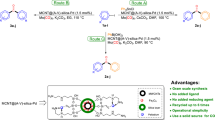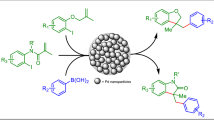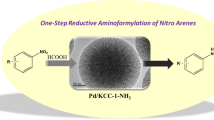Abstract
In this study, we synthesized a robust and sustainable Pd/SiO2 nanospheres catalyst. Further, its catalytic activity was demonstrated for the direct reductive coupling of nitroarenes under mild conditions. While the reaction with Pd nanoparticles on other supporting materials such as modified carbon materials and TiO2, under similar conditions, resulted formation of amines exclusively. Therefore, it was confirmed that the SiO2 was found to be the best supporting material towards the selective reductive coupling of nitroarenes. Also, the catalyst could be recycled up to five cycles with a marginal loss of product yield (< 2% yield).
Graphic Abstract










Similar content being viewed by others
References
Ferlin F, Cappelletti M, Vivani R, Pica M, Piermatti O, Vaccaro L (2019) Au@zirconium-phosphonate nanoparticles as an effective catalytic system for the chemoselective and switchable reduction of nitroarenes. Green Chem 21:614
Hu L, Cao X, Shi L, Qi F, Guo Z, Lu J, Gu H (2011) A highly active nano-palladium catalyst for the preparation of aromatic azos under mild conditions. Org Lett 13:5640
Dai Y, Li C, Shen Y, Lim T, Xu J, Li Y, Hans N, Flemming B, Lock N, Su R (2018) Light-tuned selective photosynthesis of azo-and azoxy-aromatics using graphitic C3N4. Nat Commun 9:60
Dabbagh HA, Teimouri A, Chermahini AN (2007) Green and efficient diazotization and diazo coupling reactions on clays. Dyes Pigments 73:239
Grirrane A, Corma A, García H (2008) Gold-catalyzed synthesis of aromatic azo compounds from anilines and nitroaromatics. Science 322:1661
Acharyya SS, Ghosh S, Bal R (2014) Catalytic oxidation of aniline to azoxybenzene over CuCr2O4 spinel nanoparticle catalyst. ACS Sustain Chem Eng 2:584
Lakshminarayana B, Mahendar L, Ghosal P, Satyanarayana G, Subrahmanyam Ch (2017) Nano-sized recyclable PdO supported carbon nanostructures for Heck reaction: influence of carbon materials. ChemistrySelect 2:2700
Lakshminarayana B, Mahendar L, Chakraborty J, Satyanarayana G, Subrahmanyam Ch (2018) Organic transformations catalyzed by palladium nanoparticles on carbon nanomaterials. J Chem Sci 130:47
Lakshminarayana B, Mahendar L, Ghosal P, Sreedhar B, Satyanarayana G, Subrahmanyam Ch (2018) Fabrication of Pd/CuFe2O4 hybrid nanowires: a heterogeneous catalyst for Heck couplings. N J Chem 42:1646
Lakshminarayana B, Chakraborty J, Satyanarayana G, Subrahmanyam Ch (2018) Recyclable Pd/CuFe2O4 nanowires: a highly active catalyst for C-C couplings and synthesis of benzofuran derivatives. RSC Adv 8:21030
Srinivasa Rao A, Ashok Kumar KV, Lakshminarayana B, Satyanarayana G, Subrahmanyam Ch (2019) Photocatalytic hydrogenation of nitroarenes: supporting effect of CoOx on TiO2 nanoparticles. N J Chem 43:748
Lakshminarayana B, Satyanarayana G, Subrahmanyam Ch (2018) Bimetallic Pd–Au/TiO2 nanoparticles: an efficient and sustainable heterogeneous catalyst for rapid catalytic hydrogen transfer reduction of nitroarenes. ACS Omega 3:13065
Narayana BL, Mukri BD, Subrahmanyam Ch (2016) Mn ion substituted CeO2 nano spheres for low temperature CO oxidation: the promoting effect of Mn ions. ChemistrySelect 1:3150
Lakshminarayana B, Sarker S, Subrahmanyam Ch (2018) Improved performance of Mn ion substituted ceria nanospheres for water gas shift reaction: influence of preparation conditions. Mater Res Bull 103:309
Ray S, Das P, Bhaumik A, Dutta A, Mukhopadhyay C (2013) Covalently anchored organic carboxylic acid on porous silica nano particle: a novel organometallic catalyst (PSNP-CA) for the chromatography-free highly product selective synthesis of tetra substituted imidazoles. Appl Catal A 458:183
Ray S, Brown M, Bhaumik A, Dutta A, Mukhopadhyay C (2013) A new MCM-41 supported HPF6 catalyst for the library synthesis of highly substituted 1,4-dihydropyridines and oxidation to pyridines: report of one-dimensional packing towards LMSOMs and studies on their photophysical properties. Green Chem 15:1910
Kundu PK, Dhiman M, Modak A, Chowdhury A, Polshettiwar V, Maiti D (2016) Palladium nanoparticles supported on fibrous silica (KCC-1-PEI/Pd): a sustainable nanocatalyst for decarbonylation reactions. ChemPlusChem 81:1142
Gautam P, Dhiman M, Polshettiwar V, Bhanage BM (2016) KCC-1 supported palladium nanoparticles as an efficient and sustainable nanocatalyst for carbonylative Suzuki-Miyaura cross-coupling. Green Chem 18:5890
Dhiman M, Chalke B, Polshettiwar V (2015) Efficient synthesis of monodisperse metal (Rh, Ru, Pd) nanoparticles supported on fibrous nanosilica (KCC-1) for catalysis. ACS Sustain Chem Eng 3:3224
Shokouhimehr M, Hong K, Lee TH, Moon CW, Hong SP, Zhang K, Jang HW (2018) Magnetically retrievable nanocomposite adorned with Pd nanocatalysts: efficient reduction of nitroaromatics in aqueous media. Green Chem 20:3809
Byun S, Song Y, Kim BM (2016) Heterogenized bimetallic Pd–Pt–Fe3O4 nanoflakes as extremely robust, magnetically recyclable catalysts for chemoselective nitroarene reduction. ACS Appl Mater Interfaces 8:14637
Zhou J, Li Y, Sun HB, Tang Z, Qi L, Liu L, Ai Y, Li S, Shao Z, Liang Q (2017) Porous silica-encapsulated and magnetically recoverable Rh NPs: a highly efficient, stable and green catalyst for catalytic transfer hydrogenation with “slow-release” of stoichiometric hydrazine in water. Green Chem 19:3400
Xu X, Luo J, Li L, Zhang D, Wang Y, Li G (2018) Unprecedented catalytic performance in amine syntheses via Pd/g-C3N4 catalyst-assisted transfer hydrogenation. Green Chem 20:2038
Liu X, Li HQ, Ye S, Liu YM, He HY, Cao Y (2014) Gold-catalyzed direct hydrogenative coupling of nitroarenes to synthesize aromatic azo compounds. Angew Chem Int Ed 53:7624
Li HQ, Liu X, Zhang Q, Li SS, Liu YM, He HY, Cao Y (2015) Deoxygenative coupling of nitroarenes for the synthesis of aromatic azo compounds with CO using supported gold catalysts. Chem Commun 51:11217
Li J, Song S, Long Y, Wu L, Wang X, Xing Y, Zhang H (2018) Investigating the hybrid-structure-effect of CeO2-encapsulated Au nanostructures on the transfer coupling of nitrobenzene. Adv Mater 30:1704416
Liu X, Ye S, Li HQ, Liu YM, Cao Y, Fan KN (2013) Mild, selective and switchable transfer reduction of nitroarenes catalyzed by supported gold nanoparticles. Catal Sci Technol 3:3200
Grirrane A, Corma A, Garcia H (2010) Preparation of symmetric and asymmetric aromatic azo compounds from aromatic amines or nitro compounds using supported gold catalysts. Nat Protoc 5:429
Zhu H, Ke X, Yang X, Sarina S, Liu H (2010) Reduction of nitroaromatic compounds on supported gold nanoparticles by visible and ultraviolet light. Angew Chem Int Ed 122:9851
Combita D, Concepción P, Corma A (2014) Gold catalysts for the synthesis of aromatic azo compounds from nitroaromatics in one-step. J Catal 311:339
Liu W, Zhang L, Yan W, Liu X, Yang X, Miao S, Wang W, Wang A, Zhang T (2016) Single-atom dispersed Co–N–C catalyst: structure identification and performance for hydrogenative coupling of nitroarenes. Chem Sci 7:5758
Hu L, Cao X, Chen L, Zheng J, Lu J, Sun X, Gu H (2012) Highly efficient synthesis of aromatic azos catalyzed by unsupported ultra-thin Pt nanowires. Chem Commun 48:3445
Mondal B, Mukherjee PS (2018) Cage encapsulated gold nanoparticles as heterogeneous photocatalyst for facile and selective reduction of nitroarenes to azo compounds. J Am Chem Soc 140:12592
Wang J, Yu X, Shi C, Lin D, Li J, Jin H, Chen X, Wang S (2019) Iron and nitrogen co-doped mesoporous carbon-based heterogeneous catalysts for selective reduction of nitroarenes. Adv Synth Catal 361:1
Wang Y, Peng X, Shi J, Tang X, Jiang J, Liu W (2012) Highly selective fluorescent chemosensor for Zn2+ derived from inorganic–organic hybrid magnetic core/shell Fe3O4@SiO2 nanoparticles. Nanoscale Res Lett 7:86
Eisenberg D, Kauzman W (1969) The structure and properties of water. Science 166:861
Kronenberg AK, Wolf GH (1990) Fourier transform infrared spectroscopy determinations of intragranular water content in quartz-bearing rocks: implications for hydrolytic weakening in the laboratory and within the earth. Tectonophysics 172:255
Fukuda JI (2012) Water in rocks and minerals—species, distributions, and temperature dependences. IntechOpen. https://doi.org/10.5772/35668
Wu Y, Zhang L, Li G, Liang C, Huang X, Zhang Y, Song G, Jia J, Zhixiang C (2001) Synthesis and characterization of nanocomposites with palladium embedded in mesoporous silica. Mater Res Bull 36:253
Lin J, Chen H, Fei T, Zhang J (2013) Highly transparent superhydrophobic organic–inorganic nanocoating from the aggregation of silica nanoparticles. Colloids Surf A 421:51
Manatunga DC, de Silva RM, de Silva KN (2016) Double layer approach to create durable superhydrophobicity on cotton fabric using nano silica and auxiliary non fluorinated materials. Appl Surf Sci 360:777
Rahul R, Singh RK, Bera B, Devivaraprasad R, Neergat M (2015) The role of surface oxygenated-species and adsorbed hydrogen in the oxygen reduction reaction (ORR) mechanism and product selectivity on Pd-based catalysts in acid media. Phys Chem Chem Phys 17:15146
Al-Hinai MN, Hassanien R, Wright NG, Horsfall AB, Houlton A, Horrocks BR (2013) Networks of DNA-templated palladium nanowires: structural and electrical characterisation and their use as hydrogen gas sensors. Faraday Discuss 164:71
Zhou X, Shi T (2012) One-pot hydrothermal synthesis of a mesoporous SiO2–graphene hybrid with tunable surface area and pore size. Appl Surf Sci 259:566
Cincotto FH, Canevari TC, Campos AM, Landers R, Machado SA (2014) Simultaneous determination of epinephrine and dopamine by electrochemical reduction on the hybrid material SiO2/graphene oxide decorated with Ag nanoparticles. Analyst 139:4634
Ulgut B, Suzer S (2003) XPS studies of SiO2/Si system under external bias. J Phys Chem B 107:2939
Acknowledgements
BL thanks to the University Grant Commission (UGC), New Delhi, India for the award of the fellowship.
Author information
Authors and Affiliations
Corresponding authors
Additional information
Publisher's Note
Springer Nature remains neutral with regard to jurisdictional claims in published maps and institutional affiliations.
Electronic supplementary material
Below is the link to the electronic supplementary material.
Rights and permissions
About this article
Cite this article
Lakshminarayana, B., Manna, A.K., Satyanarayana, G. et al. Palladium Nanoparticles on Silica Nanospheres for Switchable Reductive Coupling of Nitroarenes. Catal Lett 150, 2309–2321 (2020). https://doi.org/10.1007/s10562-020-03127-w
Received:
Accepted:
Published:
Issue Date:
DOI: https://doi.org/10.1007/s10562-020-03127-w




